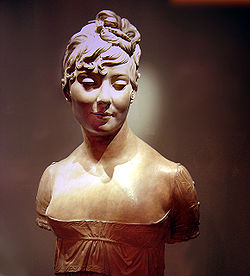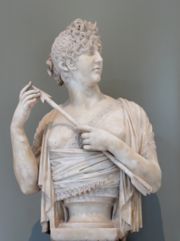
Joseph Chinard
Encyclopedia

Neoclassicism
Neoclassicism is the name given to Western movements in the decorative and visual arts, literature, theatre, music, and architecture that draw inspiration from the "classical" art and culture of Ancient Greece or Ancient Rome...
that was infused with naturalism and sentiment.
He received his early training in Lyon, as a painter, in the government-supported École Royale de Dessin, then worked with a local sculptor. His work at Lyon drew the attention of a patron who sent him to Rome, 1784-87. He sent back to Lyon copies of antiquities. In Rome he won a prize from the Accademia di San Luca
Accademia di San Luca
The Accademia di San Luca, was founded in 1577 as an association of artists in Rome, under the directorship of Federico Zuccari, with the purpose of elevating the work of "artists", which included painters, sculptors and architects, above that of mere craftsmen. Other founders included Girolamo...
, a signal honour for a non-Italian: his prize-winning sculpture, a terracotta Perseus and Andromeda remains in the collection of the Accademia.

French Revolution
The French Revolution , sometimes distinguished as the 'Great French Revolution' , was a period of radical social and political upheaval in France and Europe. The absolute monarchy that had ruled France for centuries collapsed in three years...
; in 1791 he was interned in the Castel Sant'Angelo
Castel Sant'Angelo
The Mausoleum of Hadrian, usually known as the Castel Sant'Angelo, is a towering cylindrical building in Parco Adriano, Rome, Italy. It was initially commissioned by the Roman Emperor Hadrian as a mausoleum for himself and his family...
for two months, on the orders of the Pope, for an action that were viewed as subversive, the exhibition in terracotta of a model for the base of a candelabrum in which Apollo
Apollo
Apollo is one of the most important and complex of the Olympian deities in Greek and Roman mythology...
trampled underfoot Superstition. On his release in December 1792, he was expelled and returned to Dijon.
His marble Bust of Madame de Verninac was shown in plaster at the Salon of 1800
Paris Salon
The Salon , or rarely Paris Salon , beginning in 1725 was the official art exhibition of the Académie des Beaux-Arts in Paris, France. Between 1748–1890 it was the greatest annual or biannual art event in the Western world...
and in marble (illustrated) at the Salon of 1808. Chinard made only infrequent trips to Paris, dividing his time between Lyon and Italy. On one occasion in Paris he produced the bust of Mme Récamier (now at the J. Paul Getty Museum
J. Paul Getty Museum
The J. Paul Getty Museum, a program of the J. Paul Getty Trust, is an art museum. It has two locations, one at the Getty Center in Los Angeles, California, and one at the Getty Villa in Pacific Palisades, Los Angeles, California...
), which was reproduced in marble.
Chinard sculpted a terra cotta bust of Pierre-Pomponne-Amédée Pocholle, which was exhibited in the Exposition Universelle of 1878 at the Palais du Trocadéro, in the section of Portraits Nationaux (catalogue number 440). The town of Lyon commissioned Chinard to make the bust in appreciation for Pocholle's even-handed treatment of the town during his government service there in 1794. When Pocholle became sous-prefét of Neufchâtel-en-Bray in 1804, he took the bust with him, and then gave the bust to his sister, the widowed Mrs. Delile, when he went into exile in 1816. She in turn gave the bust to Mr. Mabire, who later donated it to the newly-established museum of Neufchâtel-en-Bray in 1832. The Bulletin des Musées de France, 1er année, no. 11, novembre 1929, includes a photograph of the bust.
Much of his public sculpture in Lyon was lost during the Revolution
French Revolution
The French Revolution , sometimes distinguished as the 'Great French Revolution' , was a period of radical social and political upheaval in France and Europe. The absolute monarchy that had ruled France for centuries collapsed in three years...
. His intimate terracotta or marble family allegories adapted conventions of funeral monuments to present realistic allegories of family affection.
Interest in Chinard was revived with a retrospective of his sculpture at the Musée des Arts Décoratifs, Paris, in 1909-10.
Chinard's work may be seen in various museum collections, including those of the Louvre
Louvre
The Musée du Louvre – in English, the Louvre Museum or simply the Louvre – is one of the world's largest museums, the most visited art museum in the world and a historic monument. A central landmark of Paris, it is located on the Right Bank of the Seine in the 1st arrondissement...
, the Musée des Beaux-Arts de Lyon
Musée des beaux-arts de Lyon
The Museum of Fine Arts of Lyon is a municipal museum of fine arts in the French city of Lyon. It is housed near place des Terreaux in a former Benedictine convent of the 17th and 18th centuries. It was restored between 1988 and 1998, and despite these important restoration works it remained open...
, the Metropolitan Museum of Art
Metropolitan Museum of Art
The Metropolitan Museum of Art is a renowned art museum in New York City. Its permanent collection contains more than two million works, divided into nineteen curatorial departments. The main building, located on the eastern edge of Central Park along Manhattan's Museum Mile, is one of the...
and the National Gallery of Art, Washington

